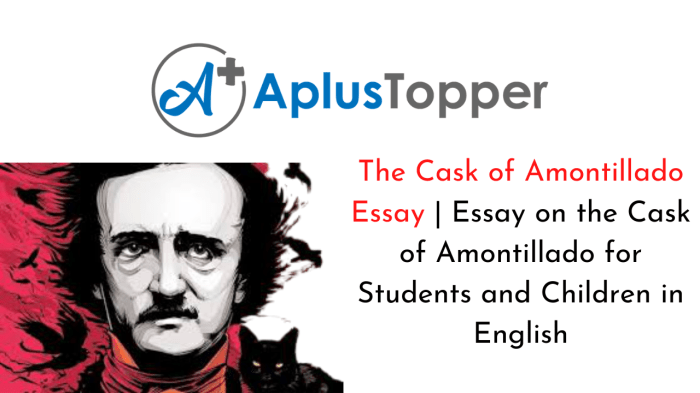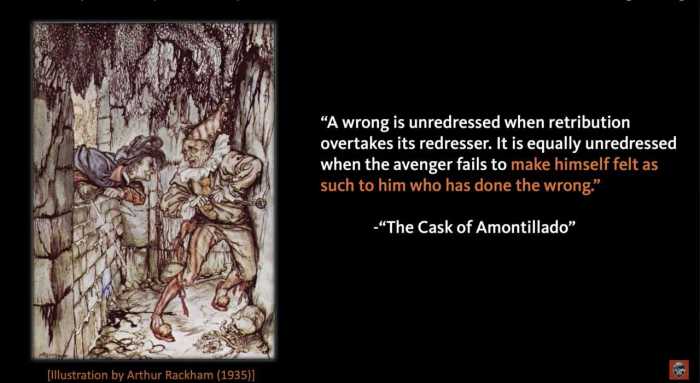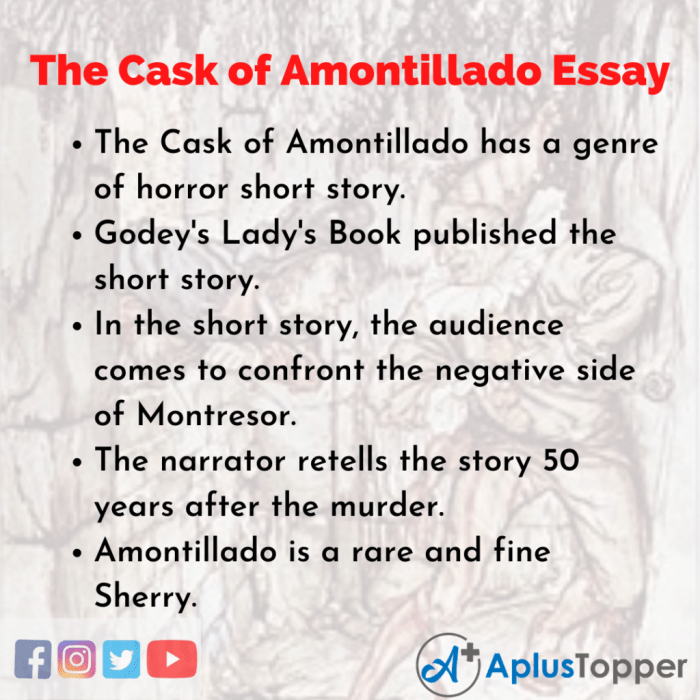The Cask of Amontillado essay delves into the captivating and haunting tale crafted by Edgar Allan Poe, exploring the themes of revenge, madness, and guilt. This essay delves into the intricacies of the story, examining its characters, setting, and the psychological aspects that drive the narrative.
Poe’s masterful use of language and imagery creates a vivid and unforgettable atmosphere, drawing readers into the depths of the characters’ minds and the unfolding drama.
Introduction

The Cask of Amontillado is a classic short story written by Edgar Allan Poe. It tells the tale of Montresor, a man who seeks revenge against his friend Fortunato for an unspecified insult. The story is set in the catacombs of an unidentified Italian city during the Carnival season.
The title of the story is significant because it refers to the cask of Amontillado, a type of Spanish fortified wine. Montresor uses the cask to lure Fortunato into the catacombs, where he intends to kill him.
Edgar Allan Poe
Edgar Allan Poe was an American writer, poet, and literary critic. He is best known for his tales of mystery and the macabre. Poe’s work has been influential in the development of the horror genre, and he is considered one of the masters of the short story.
Plot Summary

Edgar Allan Poe’s “The Cask of Amontillado” is a classic short story of revenge and retribution. The story takes place in the catacombs of an unnamed Italian city during the Carnival season. The narrator, Montresor, seeks revenge against Fortunato, who has wronged him in the past.
Setting
The story’s setting is crucial in creating a sense of claustrophobia and isolation. The catacombs are dark, damp, and filled with the smell of decay. This setting reflects Montresor’s own inner turmoil and his desire to trap Fortunato in a living tomb.
Characters
- Montresor:The narrator of the story and the perpetrator of the revenge plot. He is a cold and calculating man who is driven by a desire for retribution.
- Fortunato:Montresor’s victim. He is a wealthy and arrogant man who is unaware of Montresor’s true intentions.
Conflict and Resolution
The conflict of the story arises from Montresor’s desire for revenge against Fortunato. Montresor believes that Fortunato has insulted him and he is determined to make him pay. The resolution of the story comes when Montresor traps Fortunato in the catacombs and walls him up alive.
Themes and Motifs
The Cask of Amontillado is a haunting tale that explores the dark and twisted depths of human nature. At its core, the story is about revenge, a theme that is explored through the actions of Montresor. Montresor’s desire for revenge is driven by a deep-seated hatred for Fortunato, a man who has wronged him in the past.
Montresor’s plan for revenge is meticulously executed, and he takes great pleasure in Fortunato’s suffering.
In addition to revenge, the story also explores the themes of madness and guilt. Montresor’s obsession with revenge drives him to the brink of madness. He becomes so consumed by his desire for vengeance that he is willing to commit murder.
The Cask of Amontillado essay requires an in-depth understanding of the literary elements used by Edgar Allan Poe. While exploring this topic, you may also be interested in learning about acids and bases. For a comprehensive study guide, check out the acids and bases pogil answers resource.
Returning to The Cask of Amontillado essay, remember to analyze the character development and symbolism employed by Poe to create a haunting and unforgettable tale.
The story also explores the theme of guilt, as Montresor is haunted by his actions after he kills Fortunato.
Symbolism and Foreshadowing
Poe uses a variety of symbols and foreshadowing to create a sense of suspense and dread in the story. The cask of amontillado itself is a symbol of Montresor’s revenge. The wine represents the blood of Fortunato, and the cask represents the tomb in which he will be buried.
Poe also uses foreshadowing to hint at the dark fate that awaits Fortunato. For example, the story begins with Montresor telling the reader that he has “vowed revenge” on Fortunato. This foreshadows the violent events that will follow.
Psychological Aspects of the Characters
The Cask of Amontillado is a psychological thriller that delves into the minds of its characters. Montresor is a complex and troubled character. He is driven by a deep-seated hatred for Fortunato, and his desire for revenge consumes him. Fortunato, on the other hand, is a more sympathetic character.
He is a wealthy and respected member of society, but he is also arrogant and vain. His arrogance leads him to underestimate Montresor, and he ultimately pays the price.
Literary Techniques

Poe’s writing in “The Cask of Amontillado” is characterized by its vivid and evocative language. He employs sensory imagery to create a rich and immersive experience for the reader. The story’s setting is described in great detail, with a focus on the dampness and darkness of the catacombs.
The pacing of the story is deliberate and suspenseful. Poe builds tension slowly, gradually revealing the narrator’s sinister intentions. The story’s climax is both shocking and satisfying, as the narrator’s plan to murder Montresor is carried out with cold-blooded precision.
Irony
Irony is a literary device that involves the use of words or situations to convey a meaning that is opposite to what is stated or expected. In “The Cask of Amontillado,” irony is used to create a sense of suspense and to heighten the impact of the story’s ending.
- For example, the narrator’s claim that he is “a man to be trusted” is ironic, given his true intentions.
- Similarly, the fact that Montresor is buried alive in a cask of Amontillado is ironic, as he had intended to use the cask to kill the narrator.
Allegory
An allegory is a story that has a hidden meaning or symbolism. In “The Cask of Amontillado,” the story can be interpreted as an allegory of the dangers of revenge. The narrator’s desire for revenge against Montresor leads him to commit a heinous crime, and he ultimately pays the price for his actions.
Cultural and Historical Context

Edgar Allan Poe’s “The Cask of Amontillado” was written in the mid-19th century, a period marked by significant social and cultural shifts. The Industrial Revolution brought about rapid urbanization and technological advancements, leading to both progress and social upheaval. Gothic literature, with its emphasis on the macabre, the supernatural, and the exploration of the human psyche, was a popular genre during this time.
Influence of Gothic Literature
Poe’s work is heavily influenced by the Gothic tradition. “The Cask of Amontillado” exhibits many of the genre’s characteristic elements, including a gloomy and atmospheric setting, a focus on psychological terror, and a preoccupation with death and decay. The story’s use of symbolism and allegory reflects the Gothic fascination with the hidden and the irrational.
Relevance to Contemporary Society
While “The Cask of Amontillado” is a product of its time, its themes and motifs continue to resonate with contemporary audiences. The story’s exploration of revenge, obsession, and the destructive power of hatred remains relevant in today’s world, where social media and political polarization often exacerbate these emotions.
Adaptations and Interpretations: The Cask Of Amontillado Essay
Edgar Allan Poe’s “The Cask of Amontillado” has inspired numerous adaptations and interpretations across various mediums, including film, television, and theater. These adaptations have played a significant role in shaping the story’s legacy and its impact on popular culture.
Film Adaptations
The story has been adapted into several films, including:
- The Cask of Amontillado(1968), directed by Roger Corman, starring Vincent Price and Peter Lorre.
- The Cask of Amontillado(1995), directed by Sean Meredith, starring Jonathan Hyde and Johnathon Schaech.
- The Cask of Amontillado(2003), directed by James Toback, starring David Arquette and Sam Rockwell.
These adaptations vary in their faithfulness to the original story, but they all capture the tale’s dark atmosphere and themes of revenge and madness.
Television Adaptations
The story has also been adapted for television, including:
- An episode of the television series Alfred Hitchcock Presents(1958), starring Vincent Price.
- An episode of the television series Tales of Mystery and Imagination(1973), starring Christopher Lee.
These adaptations bring the story to a wider audience and introduce new interpretations of its characters and themes.
Theater Adaptations
The story has been adapted for the stage, including:
- The Cask of Amontillado(1964), a one-act play by Romulus Linney.
- The Cask of Amontillado(1997), a musical adaptation by William Russo and Randy Bowser.
These adaptations offer a unique and immersive experience for audiences, allowing them to engage with the story in a live setting.
Interpretations
The story has been interpreted in various ways, with critics offering different perspectives on its meaning and significance. Some common interpretations include:
- A tale of revenge:The story can be seen as a cautionary tale about the dangers of seeking revenge and the destructive consequences it can have.
- A psychological study of madness:The story explores the descent of Montresor into madness as he plots and carries out his revenge against Fortunato.
- A political allegory:The story can be interpreted as a commentary on the oppressive nature of power and the lengths to which people will go to maintain it.
Popular Culture, The cask of amontillado essay
The story has also been referenced and parodied in popular culture, including:
- The Simpsons episode “The Cask of Amontillado” (1991).
- The movie The Shawshank Redemption (1994) includes a scene where the character Red tells the story of “The Cask of Amontillado” to his fellow inmates.
- The video game BioShock (2007) features a level inspired by the story.
These references demonstrate the enduring impact of the story and its continued relevance in contemporary culture.
Essential Questionnaire
What is the significance of the title “The Cask of Amontillado”?
The title refers to the cask of Amontillado wine that Montresor uses to lure Fortunato to his doom, symbolizing the trap that Montresor sets for his victim.
How does Poe use symbolism in the story?
Poe uses the catacombs as a symbol of death and decay, while the cask of Amontillado represents the entrapment of Fortunato.
What is the main conflict in the story?
The main conflict is between Montresor and Fortunato, who have a long-standing grudge against each other.